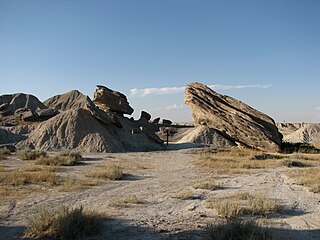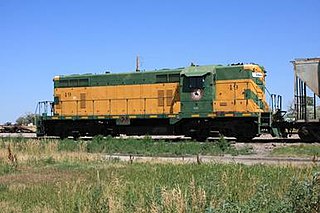
Dawes County is a county in the U.S. state of Nebraska. As of the 2010 United States Census, the population was 9,182. Its county seat is Chadron. The county was formed in 1885; it was named for James W. Dawes, the Nebraska Governor at the time.

Chadron State College is a four-year public college located in Chadron, Nebraska, in the northern part of the Nebraska Panhandle. It is one of three public colleges in the Nebraska State College System. It has open admission and an acceptance rate of 100%. It has a four-year graduation rate of 19%, which is well-below the national average.

U.S. Route 385 (US 385) is a spur of U.S. Route 85 that runs for 1,206 miles (1,941 km) from Deadwood, South Dakota to Big Bend National Park in Texas.

The Oglala National Grassland is a United States National Grassland in the northwest corner of Nebraska. It is in northern Sioux and northwestern Dawes counties, on the borders with South Dakota and Wyoming. It is 94,520 acres (38,250 ha) in size and is one of the small handful of National Grasslands administered by the US Department of Agriculture's Forest Service. It is managed by the U.S. Forest Service together with the Nebraska and Samuel R. McKelvie National Forests and the Buffalo Gap and Fort Pierre National Grasslands from common offices in Chadron, Nebraska.

Area code 308 is the telephone area code in the North American Numbering Plan for western Nebraska. It was created on July 1, 1954, by splitting the numbering plan area (NPA) 402 along a roughly S-shaped boundary line from the western half of the Nebraska–South Dakota border to approximate center of the Nebraska–Kansas border. A roughly 50-mile segment of the line running northeast to southwest in the eastern third of the state follows the Platte River.
The Rapid City Journal is the daily newspaper of Rapid City, South Dakota. It is the second-largest newspaper in South Dakota and covers Mount Rushmore, the Black Hills, the Sturgis Motorcycle Rally, and the Pine Ridge Indian Reservation.

Toadstool Geologic Park is located in the Oglala National Grassland in far northwestern Nebraska. It is operated by the United States Forest Service. It contains a badlands landscape and a reconstructed sod house. The park is named after its unusual rock formations, many of which resemble toadstools.

The Nebkota Railway was a Class III railroad that began operations in 1994 with 73.5 miles (118.3 km) of former Chicago and North Western Railway Cowboy Line track between Merriman and Chadron, Nebraska. Prior to the abandonments, the railroad hauled primarily grain along with some gravel and timber.
The Fremont, Elkhorn and Missouri Valley Railroad (FE&MV), sometimes called "the Elkhorn," was a railroad established in 1869 in the state of Nebraska in the Midwestern United States.

The Dakota Formation is a sedimentary geologic formation composed of sandstone, mudstone, and shale deposited in the late-Early to early-Late Cretaceous Western Interior Seaway. The unit is noted for being exceptionally widespread, producing massive colorful rock formations, and preserving dinosaur footprints and early deciduous tree leaves.
The White River Fauna are fossil animals found in the White River Badlands of South Dakota, Wyoming and Nebraska in the United States including Badlands National Park.
Trigenicus is an extinct genus of small artiodactyl in the family Protoceratidae, endemic to North America. It lived from the Late Eocene 37.2—33.9 Ma, existing for approximately 3 million years. Trigenicus resembled deer, but were more closely related to camelids.

The Mowry Shale is a Late Cretaceous geologic formation. The formation was named for Mowrie Creek, northwest of Buffalo in Johnson County, Wyoming. The Mowry crops out or occurs at depth in parts of Colorado, Montana, North Dakota, South Dakota, Utah and Wyoming. It occurs within the following geologic regions:
The Nebraska Northwestern Railroad is a Class III railroad that began operations in April 2010 after it purchased 7.22 miles (11.62 km) of former Dakota, Minnesota and Eastern, now Rapid City, Pierre and Eastern Railroad, previously Chicago and North Western Railway Cowboy Line track between Dakota Junction and the rail yard at Chadron, Nebraska. In addition to the 7.22 miles of owned track, the railroad leased the line between the connection with the DME Rapid City line at Dakota Junction and the connection with BNSF Railway at Crawford, Nebraska.

The Brule Formation was deposited between 33 and 30 million years ago, roughly the Rupelian age (Oligocene). It occurs as a subunit of the White River Formation in Nebraska, Colorado, North Dakota, South Dakota, and Wyoming.
Ray Dreyer Hahn was an American football and basketball player and coach.
The White River Formation is a geologic formation of the Paleogene Period, in the northern Great Plains and central Rocky Mountains, within the United States.
U.S. Route 385 (US 385) is a part of the United States Numbered Highway System that travels from Big Bend National Park in Texas to US 85 in Deadwood, South Dakota. Within the state of Nebraska, the highway is known as the Gold Rush Byway, one of nine scenic byways across the state. The highway follows along the old Sidney-Black Hills trail which played a crucial role during the Black Hills Gold Rush in the late 1870s. It served as the primary route to transport gold and mining gear between Sidney, Nebraska and the Black Hills to the north. Today, the highway enters Nebraska in the southeastern portion of the Nebraska Panhandle on the state line with Colorado northeast of Julesburg and continues in a northerly direction to the South Dakota state line north of Chadron.

Olive Ann Moorman Leader was a temperance reformer.











